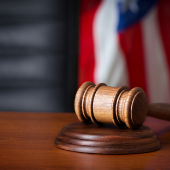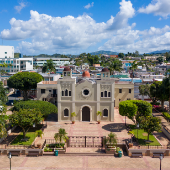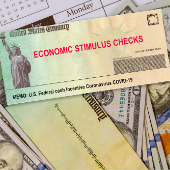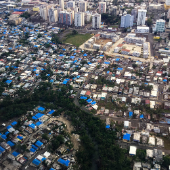
Published on December 3, 2020 / Leer en español
Dear Readers:
As the year slowly draws to a close it is normal, perhaps even expected, to look back at the events and experiences that shaped our lives in the year that was. December is like no other time of the year, a canvas into which we can project a wide array of emotions, both our joys and our reflections. Certainly, 2020 will be one of the most consequential and eventful years of our lifetimes. The year when globalization stopped in its tracks; when many of us (re) considered the value of the rat race we used to call “normal” life; and when we realized how fragile this ostensibly modern world we live in really is.
That is why we bring you this week some highlights of CNE’s work during this complicated year of earthquakes; pandemic disease; stalled reconstruction efforts; and an ongoing bankruptcy process. We hope you find this useful as you carry on your own year-end thinking and reflection.
Finally, the pandemic is still raging around the world, even as I write this introduction, especially in the United States, while Puerto Rico has experienced a surge in new cases, hospitalizations, and unfortunately deaths. Yes, vaccines are on the way, but we are still about seven to eight months away from having vaccinated enough people to fully control the spread of the virus.
Until then, the cold, hard reality is that after eight months we have failed to strengthen our public health capabilities. Thus, we have no good options left. Some public health specialists are calling for implementing a two-week total lockdown. This may sound like a strong measure, which it is, but it is unlikely to work. According to Dr. Michael Osterholm, director of the Center for Infectious Disease Research and Policy at the University of Minnesota, we need a 4 to 6-week lockdown to truly bring the virus under control.
Unfortunately, if we do that without new assistance from the federal government for state and local governments, small and medium enterprises, and struggling families, we risk rising unemployment, increased poverty and despair, and possibly inflicting permanent long-term economic damage, as Osterholm himself recognizes in this op-ed for the New York Times he coauthored with Neel Kashkari, president of the Federal Reserve Bank of Minneapolis.
Yet, we cannot afford either to let the virus run wild or to impose a Gestapo-like police state to enforce the lockdown. Therefore, at this point in time, our best, but imperfect options consist of, first, to continue encouraging people to wash their hands, use masks, and keep social distancing; and second, start preparing field hospitals, building out temporary isolation units, acquiring ventilators, stocking up on personal protective equipment for health professionals, and increasing the inventory of therapeutics that have proven effective in lowering the COVID-19 mortality rate. The winter/holiday surge is inevitable, we might as well be prepared.
In absence of new federal support, that is the best we can do, not only here but in many states as well. We do hope, though, that government officials in Washington are listening, and hopefully, getting ready to act.
—Sergio M. Marxuach, Editor-in-Chief
Ten Highlights of CNE's Work During 2020
In 2020, CNE produced hundreds of daily briefings and weekly reviews, policy briefs, empirical research reports, evidence-based analyses, and op-eds. We highlight the following ten because they garnered the most interest from our readers and are particularly relevant to the challenges Puerto Rico faces.

1. Agreement Between PREPA and LUMA
One of the most important developments in the energy sector this year was the execution of an agreement between the Puerto Rico Electric Power Authority (“PREPA”) and LUMA Energy for the operation and management of PREPA’s transmission and distribution system. CNE published a policy brief analyzing the Agreement; highlighting some risks associated with its performance; identified several reservations we have with the transaction; and offered some recommendations for its improvement.

2. Background to the Current Crisis
As we all know, 2020 was an election year (how can we ever forget it?). About two months prior to the election we thought it was appropriate to take a look at cutting-edge or innovative economic policy ideas that could be implemented by new administrations in Puerto Rico and the U.S. Our seven-week series, Focus 2020, posed questions about some of the many issues affecting Puerto Rico, such as economic stagnation, the post-Maria reconstruction process, and the roles of the government and the private sector as they relate to economic development.
We thought it was important, though, to understand first the economic policy successes and failures of the last few decades before plunging into the world of new policy ideas. Thus, our first installment was a brief economic history of Puerto Rico since 1945. We often forget that our economic troubles did not start with the debt default in 2015. In fact, it could be argued that the default was essentially a function of a long-stagnant economy.

3. FOMB v. Aurelius
The Supreme Court of the United States issued an important opinion regarding the appointment of the members of the Fiscal Oversight and Management Board (“FOMB”). The Court ruled that the appointment of the members of the FOMB did not violate the Appointments Clause of the U.S. Constitution. The Appointments Clause states that the President “shall nominate, and by and with the Advice and Consent of the Senate, shall appoint Ambassadors, other public Ministers and Consuls, Judges of the Supreme Court, and all other Officers of the United States . . .” (Art. II, §2, cl. 2). The members of the FOMB were appointed pursuant to a complicated process that did not require the advice and consent of the Senate.

4. The Impact of SSI in Puerto Rico
The Supplemental Security Income (SSI) program was created by Congress in 1972 to replace the Aid to the Aged, Blind, or Disabled (AABD) program and to provide cash assistance to the aged, blind, and disabled individuals with limited resources to meet basic living expenses. It is available to residents of the U.S. states, the District of Columbia, and the Commonwealth of the Northern Mariana Islands. However, the old AABD program continues to operate in Puerto Rico, Guam, and the U.S. Virgin Islands, while SSI does not.
On April 10, the U.S. Court of Appeals for the First Circuit issued an opinion upholding a decision of the Federal District Court for Puerto Rico, which held such discrimination to be unconstitutional under the Equal Protection Clause of the U.S. Constitution. The decision, if not overturned by the Supreme Court, could benefit more than 400,000 persons in Puerto Rico, who would qualify for about $2.5 billion in annual benefits, according to Rosanna Torres’s analysis, director of CNE’s office in Washington, D.C.

5. The Effect of Austerity Policies on Municipalities
Raúl Santiago Bartolomei, Ph.D., CNE’s Research Associate, analyzed the municipal reforms set forth in the most recent Fiscal Plan for Puerto Rico, as certified by the FOMB. He specifically evaluated proposals to (1) eliminate, in phases, all transfers of funds from the central government to the municipalities to carry out delegated tasks (for some municipalities, these transfers represent about 80% of their budget), (2) reform the property tax system to increase revenues, and (3) consolidate municipal services across regions or counties.

6. The Importance of State Capacity
Puerto Rico is facing simultaneous crises: bankruptcy; a sluggish post-Maria reconstruction; and the COVID-19 pandemic. Addressing each one of these crises calls for a high level of state capacity to implement complex policies. Once upon a time, Puerto Rico had a high degree of state capacity, defined as “the set of skills, capabilities, and resources necessary to perform policy functions, from the provision of public services to policy design and implementation.” With time, however, those skills, capabilities, and resources eroded due to several reasons: the dismantling of the professional civil service; the outsourcing and privatization of key capabilities; and years of diminished financial resources due to austerity policies. Yet, Puerto Rico’s government is being called to execute at a high level. This gap between low capacity and high expectations is perhaps the most important political issue we face right now, yet no one seems to talk about it, as my colleague Deepak Lamba Nieves, Ph.D. and I write in this analysis of state capacity in Puerto Rico.

7. Unemployment Compensation Cliff
As the COVID-19 pandemic spread across the United States, state and local governments were forced to shut down economic activity to slow down the rate of infection. These measures led to a big increase in unemployment. Congress responded by enacting several economic relief bills, including the Coronavirus Aid, Relief, and the Coronavirus Aid, Relief and Economic Security (CARES) Act, which provided much-needed assistance to both businesses and unemployed workers. Yet, even as the pandemic continued to rage, Congress let the additional unemployment benefits to lapse, as Rosanna Torres states in her analysis of what we can call the “Unemployment Compensation cliff”.

8. Industrial Policy for the 21st Century
Even if we set aside the economic harm caused by the 2017 hurricanes, the recent earthquakes, and the COVID-19 pandemic, it is clear the Puerto Rican economy has been on a path of secular stagnation for at least a decade. This is not to say the reconstruction of the capital endowment damaged or destroyed by the natural disasters, or assisting both businesses and households adversely affected by the COVID-19 pandemic are not important. Those are, however, necessary but insufficient conditions to reignite economic growth in Puerto Rico. We also have to work on improving our anemic capacity to produce endogenous growth and on reforming our institutions. That is why we dedicated an installment of our Focus 2020 series to look at how the implementation of a modern industrial policy could help on both fronts: generating endogenous growth and spearheading institutional reforms.

9. Land Value Capture
What is land value capture (“LVC”)? As Raúl Santiago Bartolomei and Deepak Lamba Nieves show in this short explanation, land value capture refers to a series of policy instruments that a local government can implement to “capture”—through taxation, fees, or acquisition—a fraction of the value that is added to development costs by way of speculation and market pricing. Once the added value is “captured”, local governments can redistribute it by making strategic investments in infrastructure improvements, affordable housing, or public amenities, prioritizing low-income households. Common instruments used for LVC include land value taxation, development impact fees, charges on building rights, community land trusts, and land banking.

10. Transformation During Pandemic Times
This year we welcomed Jennifer Wolff, Ph.D., back to CNE as head of our bureau in Madrid, Spain. In this piece, Jennifer writes about the plan presented by President Pedro Sánchez (PSOE) to turn-around the post-pandemic Spanish economy by setting the stage for an expansive spending policy that aims to shape state budgets for the next seven years. According to Jennifer’s analysis, the Plan focuses on ten key policies from which Puerto Rico could draw important lessons for the future, among which are the digitization and decarbonization of the economy, the renewal of technological capital, the increased internationalization of local companies, greater integration into regional transport corridors, and the implementation of social policies that ensure the integration of women and precarious groups into the transformation process.
